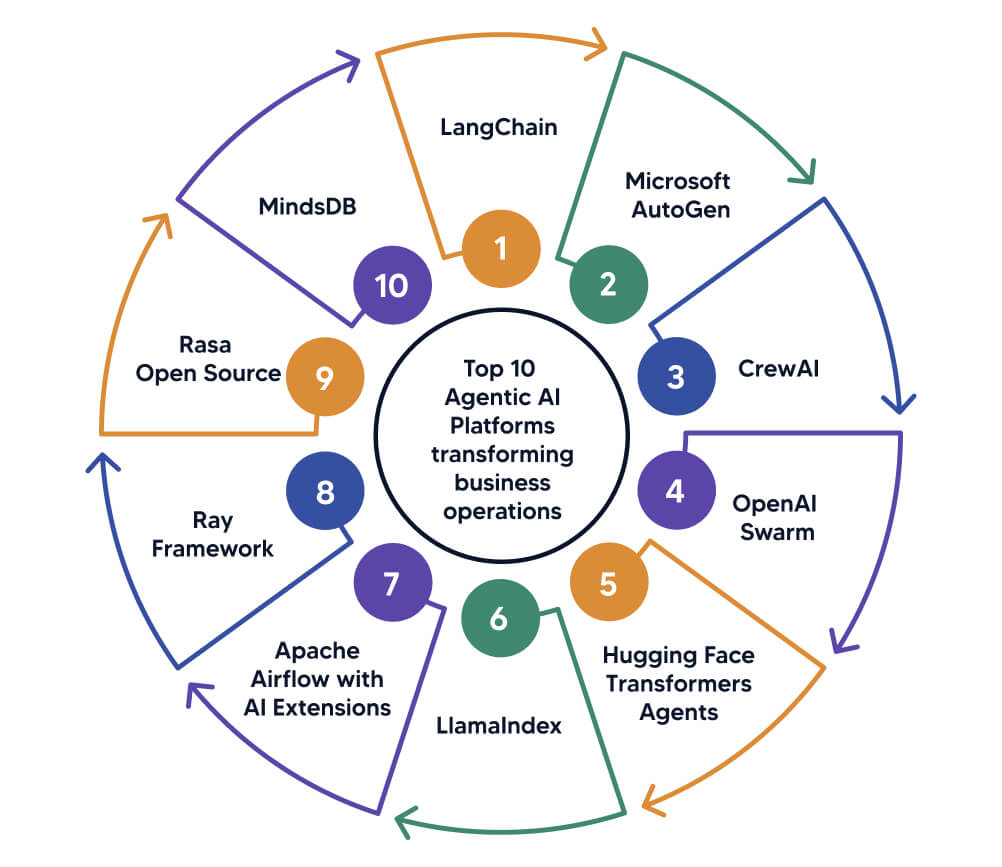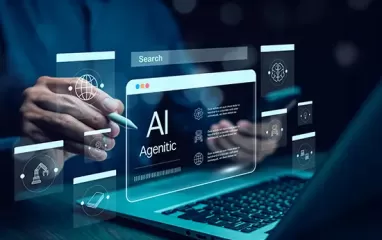Other recent blogs



Let's talk
Reach out, we'd love to hear from you!
In boardrooms across industries, a silent revolution is unfolding while business leaders are grappling with operational complexities and competitive pressures. Yes, we are here, straightforwardly referring to the newest advancement in Artificial Intelligence dynamics, which is emerging as a game-changer.
The Multimodal AI agents are nothing less than cognitive powerhouses, reflecting a shift in how businesses operate fundamentally. Promising AI transformation from generative AI to comprehensive intelligence, the convergence of multiple AI modalities from text to image, audio, and video into unified intelligent agents represents the most significant technological leap since the advent of the Internet.
In this blog, we will explore how multimodal AI applications are revolutionizing everything from customer interactions to internal workflows and creating unprecedented opportunities for efficiency and innovation. We'll dive deep into the top 10 multimodal AI Agent platforms driving this transformation.
From data points to transformation: The statistical overview
The multimodal AI market has surpassed $1.6 billion in 2024 and is projected to grow at a CAGR of over 32.7% from 2025 to 2034. According to Gartner's latest research, forty percent of generative AI solutions will be multimodal (text, image, audio, and video) by 2027, up from 1% in 2023. Even more striking, 80% of enterprise software and applications will be multimodal by 2030, up from less than 10% in 2024. These projections indicate not just growth but an exponential shift in how businesses will interact with AI systems.
79% of organizations revealed in a report that at some level, companies are adopting AI Agents across a range of sectors, from finance and insurance to healthcare, tech, and even manufacturing. Yet beneath these promising statistics lies a critical question: Are we witnessing the emergence of systems that approach Artificial General Intelligence (AGI) or simply more sophisticated versions of existing technologies? The answer has profound implications for strategic planning, investment decisions, and competitive positioning in the coming decade.
AI agents and AI-ready data are the two fastest advancing technologies on the 2025 Gartner Hype Cycle for Artificial Intelligence, signaling an unprecedented acceleration in enterprise adoption. This isn't merely another incremental improvement in automation; it represents a paradigm shift toward systems that can perceive, reason, and act across multiple sensory channels simultaneously.
The rise of Multimodal AI Agent applications: What you need to know
At its core, a multimodal AI agent represents an integrated system capable of processing and generating content across multiple input and output modalities. It combines natural language processing, computer vision, speech recognition, and generation capabilities into a unified intelligence framework. Unlike traditional AI systems that operate within singular domains, these agents can seamlessly switch between text analysis, image interpretation, audio processing, and video understanding within a single workflow.
These multi-modal agentic applications function as autonomous decision-makers that can perceive their environment through multiple senses, process complex information patterns, and execute actions based on a comprehensive understanding rather than narrow programmatic rules. They represent a fundamental evolution from reactive systems to proactive intelligence that can anticipate needs, identify opportunities, and solve problems with minimal human intervention.
The practical implications for enterprise operations are transformative. Consider a customer service scenario where a multimodal AI agent simultaneously analyzes written complaints, interprets product images, processes voice tone indicators, and accesses video documentation to provide comprehensive solutions. Or imagine supply chain management where agents monitor text-based reports, satellite imagery, audio communications, and video feeds to predict and prevent disruptions before they cascade through operations.
Key benefits of Multimodal AI Agents driving enterprise adoption: The quantifiable impact
The business case for multimodal AI agents transcends mere technological advancement—it represents a fundamental reimagining of operational excellence. Early adopters are already witnessing transformational results that cascade across every aspect of their organizations, from frontline operations to C-suite decision-making. Here are the core benefits and impacts of using Multimodal AI agents:
Superior decision intelligence through contextual synthesis
Traditional AI systems operate in isolation, analyzing data through single lenses that miss critical contextual connections. Multimodal agents revolutionize this approach by creating comprehensive situational awareness that mirrors human cognitive processes.
Consider a manufacturing quality control scenario: while conventional systems might flag statistical anomalies in production data, a multimodal agent simultaneously analyzes production metrics, visual equipment inspections, acoustic pattern recognition from machinery, and historical maintenance reports to predict failures weeks before they occur.
This holistic intelligence translates into measurably superior outcomes. Organizations report 35-50% improvements in prediction accuracy and reductions in false positives when deploying multimodal decision-support systems. The strategic implications extend beyond operational efficiency—these systems enable proactive rather than reactive business strategies.Operational transformation via intelligent automation
The efficiency gains from multimodal agents fundamentally restructure how work gets accomplished. Rather than managing disparate AI tools that require constant human interpretation and coordination, organizations deploy unified intelligent systems that handle end-to-end processes autonomously.
Take customer service operations as an example: a multimodal agent doesn't just process text-based inquiries—it simultaneously analyzes customer tone and sentiment from voice interactions, interprets product images for visual troubleshooting, reviews purchase history and warranty documentation, and even processes video submissions for complex technical issues. This comprehensive approach reduces average resolution times from hours to minutes while improving customer satisfaction scores.
The multiplication effect is profound. Where organizations previously required specialized teams for different communication channels and problem types, multimodal agents enable lean, responsive operations that scale effortlessly with demand fluctuations.Strategic cost advantages beyond simple consolidation
The financial impact of multimodal AI agents extends well beyond infrastructure consolidation, though those savings alone are substantial. Organizations typically reduce AI-related technology costs by 40-60% by replacing multiple specialized systems with unified platforms. However, the more significant economic impact comes from operational leverage and speed-to-market advantages.
Traditional AI implementations require extensive integration projects, custom development for each use case, and ongoing maintenance of complex technical ecosystems. Multimodal agents eliminate these friction points through inherent versatility and adaptability. A single deployment can handle customer service, quality control, document processing, and compliance monitoring without requiring separate implementations or specialized technical teams.
The training and change management costs also decrease dramatically. Instead of requiring employees to learn multiple AI tools and interfaces, organizations can standardize on unified platforms that handle diverse requirements through natural, intuitive interactions.Adaptive intelligence to future-proofing business operations
Perhaps the most strategically valuable characteristic of multimodal agents is their capacity for continuous learning and adaptation. Unlike traditional automation systems that become obsolete as business requirements evolve, these agents demonstrate remarkable flexibility in applying learned patterns to novel situations.
This adaptability manifests in practical ways that directly impact business agility. When market conditions shift, product lines expand, or new regulatory requirements emerge, multimodal agents can rapidly adjust their operations without extensive reprogramming or retraining. Organizations that leverage multimodal agent platforms report faster adaptation times for new business processes and reduced change management costs.
Top 10 Agentic AI Platforms transforming business operations

- LangChain
LangChain has established itself as the foundational framework for building sophisticated agentic applications, offering comprehensive tools for creating chains of reasoning that span multiple AI models and data sources. The platform provides robust integration capabilities with virtually every major language model, vector database, and external API, making it the go-to choice for organizations building complex multi-step AI workflows.
The framework's strength lies in its modular architecture, allowing developers to construct sophisticated agents that can reason through problems, access external tools, and maintain conversation context across extended interactions. LangChain's memory management capabilities enable agents to learn from previous interactions and build upon accumulated knowledge, creating systems that become more effective over time.
Key benefits include extensive model compatibility, comprehensive documentation and community support, powerful chain-of-thought reasoning capabilities, and seamless integration with existing enterprise systems. Organizations leveraging LangChain report significant reductions in development time for complex AI applications and improved reliability in production environments.
- Microsoft AutoGen
AutoGen represents Microsoft's vision for collaborative AI systems, enabling multiple specialized agents to work together on complex problems through structured conversations and coordination protocols. The platform excels at orchestrating teams of AI agents, each with specialized capabilities, to tackle multifaceted business challenges that require diverse expertise.
The framework's conversation-driven approach allows organizations to model complex business processes as multi-agent collaborations, where different agents represent various departments, expertise areas, or decision-making authorities. This approach mirrors natural human organizational structures while leveraging AI capabilities for enhanced efficiency and consistency.
AutoGen's integration with Microsoft's ecosystem provides seamless connectivity with Azure services, Office 365 applications, and Power Platform tools. Organizations can deploy agents that automatically coordinate across existing Microsoft infrastructure, reducing implementation complexity and accelerating time-to-value.
Benefits include natural integration with Microsoft enterprise tools, sophisticated multi-agent coordination capabilities, robust conversation management features, and comprehensive monitoring and governance tools. Companies report improved cross-departmental collaboration and more consistent decision-making processes when implementing AutoGen-based solutions.
- CrewAI
CrewAI revolutionizes team-based AI operations by providing a framework specifically designed for creating and managing crews of collaborative AI agents. The platform treats AI agents as team members, each with defined roles, responsibilities, and collaborative protocols, enabling sophisticated delegation and coordination mechanisms.
The framework's role-based architecture allows organizations to model complex business processes as agent teams, where each agent brings specialized knowledge and capabilities to collective problem-solving efforts. CrewAI's hierarchical task management ensures that complex projects are broken down into manageable components and distributed across appropriate agents based on their expertise.
What sets CrewAI apart is its focus on agent personality and communication styles, enabling more natural interactions between AI agents and human team members. The platform supports custom agent personas that align with organizational culture and communication preferences, facilitating smoother integration with existing teams.
Key advantages include intuitive role-based agent design, sophisticated task delegation and coordination, customizable agent personalities and communication styles, and comprehensive project management capabilities. Organizations implementing CrewAI report improved project completion rates and enhanced collaboration between human and AI team members.
- OpenAI Swarm
Swarm represents OpenAI's experimental approach to lightweight multi-agent coordination, focusing on simplicity and ease of implementation for organizations new to agentic AI systems. The framework emphasizes handoff patterns between agents, enabling smooth transitions of responsibility as tasks evolve and require different expertise.
The platform's minimalist design philosophy makes it accessible to organizations with limited AI development experience while still providing powerful coordination capabilities. Swarm's focus on clear handoff protocols ensures that complex workflows maintain coherence and accountability as they move between different specialized agents.
Swarm's integration with OpenAI's model ecosystem provides access to cutting-edge language capabilities while maintaining simplicity in implementation and management. The framework's lightweight nature makes it ideal for proof-of-concept projects and rapid prototyping of agentic systems.
Benefits include low barrier to entry for multi-agent systems, clear and intuitive handoff patterns, seamless OpenAI model integration, and excellent documentation and examples. Companies appreciate Swarm's ability to deliver quick wins while building organizational confidence in agentic AI approaches.
- Hugging Face Transformers Agents
Hugging Face has democratized access to state-of-the-art AI models through their Transformers Agents framework, providing organizations with direct access to thousands of pre-trained models and the tools to combine them into sophisticated multimodal agents. The platform's open-source ethos and extensive model library make it invaluable for organizations seeking cutting-edge capabilities without vendor lock-in.
The framework's strength lies in its vast ecosystem of pre-trained models covering every conceivable AI task, from natural language processing to computer vision to audio analysis. Organizations can rapidly prototype and deploy agents that leverage multiple models simultaneously, creating sophisticated multimodal applications with minimal custom development.
Hugging Face's commitment to open science and reproducible research ensures that organizations have access to the latest research developments and can build upon community contributions. The platform's model hub serves as a constantly expanding resource of capabilities that can be integrated into existing agentic systems.
Key benefits include access to thousands of state-of-the-art models, strong open-source community support, comprehensive multimodal capabilities, and freedom from vendor lock-in. Organizations report accelerated innovation cycles and reduced dependency on proprietary AI services when adopting Hugging Face-based solutions.
- LlamaIndex
LlamaIndex specializes in connecting language models with enterprise data sources, enabling organizations to build agents that can reason over proprietary information while maintaining security and governance requirements. The platform's focus on data integration and retrieval-augmented generation makes it essential for organizations deploying AI agents that must access and reason over complex internal data landscapes.
The framework provides sophisticated indexing and retrieval mechanisms that enable agents to efficiently access relevant information from vast data repositories. LlamaIndex's query engines can understand complex information requests and retrieve precisely relevant context, enabling more accurate and informed agent responses.
LlamaIndex's enterprise-grade security features ensure that sensitive data remains protected while still enabling AI agents to leverage organizational knowledge effectively. The platform's governance tools provide audit trails and access controls that meet enterprise compliance requirements.
Benefits include sophisticated data integration capabilities, enterprise-grade security and governance, optimized retrieval and indexing performance, and comprehensive support for various data formats. Organizations implementing LlamaIndex report improved decision quality and reduced time-to-insight for complex analytical tasks.
- Apache Airflow with AI Extensions
Apache Airflow has evolved beyond traditional workflow orchestration to become a powerful platform for managing complex AI agent pipelines and multi-step reasoning processes. The platform's directed acyclic graph (DAG) architecture provides the perfect foundation for orchestrating sophisticated agentic workflows that require precise sequencing and dependency management.
Airflow's extensibility through custom operators enables organizations to integrate any AI model or service into sophisticated workflow pipelines. The platform's robust monitoring and logging capabilities provide complete visibility into agent operations, enabling effective debugging and optimization of complex agentic processes.
The framework's enterprise-grade reliability features, including automatic retries, failure handling, and resource management, ensure that critical agentic workflows maintain high availability and performance even under demanding conditions. Airflow's scalability enables organizations to deploy agents across distributed infrastructure while maintaining centralized control and monitoring.
Key advantages include enterprise-grade workflow orchestration, comprehensive monitoring and logging capabilities, extensive integration possibilities, and proven scalability for large-scale deployments. Organizations report improved reliability and maintainability of complex AI agent deployments when using Airflow-based architectures.
- Ray Framework
Ray provides the distributed computing foundation necessary for deploying sophisticated AI agents at enterprise scale, offering seamless scaling from single machines to massive clusters while maintaining consistent performance and reliability. The framework's unified API abstracts the complexity of distributed computing, enabling organizations to focus on agent logic rather than infrastructure management.
Ray's strength in hyperparameter tuning and model training makes it invaluable for organizations developing custom agentic capabilities. The platform's distributed training capabilities enable rapid iteration and optimization of agent behaviors, accelerating the development cycle for custom solutions.
The framework's production-ready serving capabilities ensure that agents can handle enterprise-scale workloads with consistent performance and reliability. Ray's automatic scaling features adapt resource allocation based on demand, optimizing costs while maintaining service levels.
Benefits include seamless distributed computing capabilities, advanced hyperparameter optimization, production-ready model serving, and automatic resource scaling. Organizations implementing Ray report significant improvements in training efficiency and production reliability for complex AI agent deployments.
- Rasa Open Source
Rasa specializes in conversational AI and dialogue management, providing the foundation for building sophisticated multimodal agents that can engage in natural, contextual conversations while maintaining conversation state and intent understanding. The platform's focus on conversational intelligence makes it essential for customer-facing agentic applications.
The framework's advanced natural language understanding capabilities enable agents to interpret complex user intents, extract relevant entities, and maintain conversational context across extended interactions. Rasa's custom action framework allows agents to integrate with external systems and perform complex operations based on conversational inputs.
Rasa's emphasis on data privacy and on-premises deployment options makes it attractive for organizations with strict data governance requirements. The platform's training pipeline enables organizations to develop custom conversational models that understand domain-specific language and business contexts.
Key advantages include sophisticated conversation management, advanced natural language understanding, privacy-focused deployment options, and extensive customization capabilities. Organizations report improved customer satisfaction and reduced support costs when implementing Rasa-based conversational agents.
- MindsDB
MindsDB bridges the gap between traditional databases and AI capabilities, enabling organizations to deploy intelligent agents that can reason over structured data using natural language interfaces. The platform's unique approach treats machine learning models as virtual database tables, simplifying the integration of AI capabilities into existing data infrastructure.
The framework's strength lies in its ability to make AI accessible to business users who understand data but may not have deep technical AI expertise. MindsDB's SQL-based interface enables data analysts and business intelligence professionals to leverage sophisticated AI capabilities using familiar query languages and tools.
MindsDB's automated machine learning capabilities enable organizations to rapidly develop custom models for specific business use cases without requiring extensive data science expertise. The platform's model management features ensure that AI capabilities remain current and effective as business conditions evolve.
Benefits include simplified AI integration with existing data infrastructure, accessible SQL-based AI interfaces, automated machine learning capabilities, and comprehensive model lifecycle management. Organizations implementing MindsDB report democratized access to AI capabilities and accelerated deployment of data-driven intelligent systems.
How does Kellton enable seamless multimodal AI platform integration?
Navigating the complex landscape of agentic AI platforms requires deep technical expertise and a strategic understanding of enterprise requirements. Kellton brings over two decades of digital transformation experience to help organizations identify, implement, and optimize the right combination of these 10agentic AI platforms for their specific business contexts.
Our approach begins with a comprehensive assessment of existing infrastructure, business processes, and strategic objectives to determine the optimal platform selection and integration strategy. We understand that successful agentic AI implementation requires more than technology deployment—it demands organizational change management, process redesign, and cultural adaptation to maximize value realization.
Kellton's technical teams possess deep expertise across all major agentic AI platforms, enabling us to design hybrid solutions that leverage the strengths of multiple frameworks while mitigating individual platform limitations. Our integration approach ensures that multimodal AI agents operate seamlessly within existing enterprise architectures while providing clear migration paths for future platform evolution.
We provide end-to-end support from initial strategy development through production deployment and ongoing optimization. Our methodology includes risk assessment, pilot project development, scaled implementation, and continuous improvement processes that ensure long-term success and value generation from agentic AI investments.
The path forward: Strategic implications and next steps
The rise of multimodal AI agents represents more than a technological evolution—it signals a fundamental shift in how organizations can approach problem-solving, decision-making, and value creation. While we may not yet be at the threshold of true Artificial General Intelligence, the capabilities demonstrated by current multimodal AI agents suggest we are entering an era where the boundaries between human and artificial intelligence become increasingly blurred.
Organizations that successfully integrate these capabilities into their core operations will gain significant competitive advantages through enhanced efficiency, improved decision quality, and accelerated innovation cycles. However, success requires more than technology adoption—it demands thoughtful integration that aligns with business strategy, organizational culture, and long-term vision.
The future of business intelligence is multimodal, autonomous, and increasingly powerful. While the path to AGI remains uncertain, the immediate benefits of deploying sophisticated multimodal AI agents are clear and measurable. Kellton's expertise in agentic AI platforms and enterprise integration can help your organization navigate this transformation successfully. Our proven methodology ensures that your investment in multimodal AI agents delivers immediate value while positioning your organization for future AI developments.
The question is not whether multimodal AI agents will transform business operations, but how quickly organizations can adapt to leverage these capabilities effectively. The window for competitive advantage through early adoption is narrowing rapidly as these technologies mature and become more accessible.
Ready to transform your business operations with Multimodal AI Agents?
Contact Kellton today.


